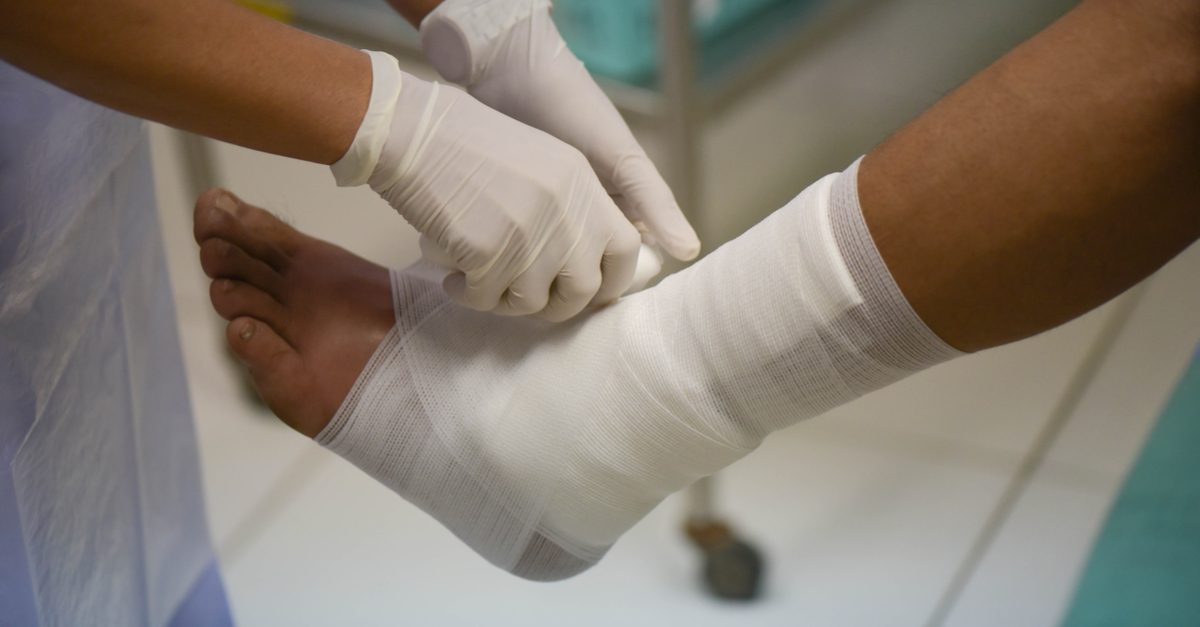If you have been in the podiatry field for any amount of time, then you know the importance of wound care products. Foot and lower-leg wounds require specialized wound care, particularly in patients who are at high risk for complications. Understanding the purpose of a dressing, the dressing categories, and what makes up a dressing prescription can improve the quality of care that podiatrists are able to provide their patients.
Podiatrists see patients with a wide range of conditions that can significantly increase the risk of wounds—from diabetes to peripheral artery disease.
And anyone who is susceptible to blood clotting due to age, genetic disorders, or lack of mobility needs specialized types of podiatry supplies to treat lower-extremity wounds.
Patients with wound conditions, be it minor or severe, can benefit greatly from a prescribed at-home wound-dressing regimen. It offers a convenient and affordable way for the patient to treat their wounds in the comfort of their own home.
This type of prescribing can also benefit the podiatrist’s practice by freeing up dressing time and offering a selection of wound care products for patients to purchase—many of which are billable to insurance.[1]
The podiatrist is often the hub when there are many different spokes to the wound-management team. Because wound care can often require specialists from various fields of medicine, the patient greatly benefits from the podiatrist’s ability to prescribe wound care products and communicate proper application.
A CLOSER LOOK AT WOUND CARE PRODUCTS
Alginate Dressings[2]
Alginate podiatry supplies start out dry, but when they come into contact with exudate fluids from the wound, they transform into a gel-like substance. This material helps clean out the wound, protect against bacteria, promote new skin growth, and encourage natural debridement.
Alginate dressings should be considered when there is an excessive amount of wound drainage since they can absorb up to 20 times their weight. Wounds such as pressure ulcers, diabetic foot ulcers, cavity wounds, venous leg ulcers, post-operative wounds, trauma wounds, and partial-thickness burns are all good candidates for alginate dressings.
Hydrogel Dressings
Hydrogel dressings are a great way to provide hydration to a wound. Hydrogels are made of 90% water and thus are helpful in maintaining a moist wound environment.
Hydrogel dressings generally come in 3 forms, including…
Amorphous hydrogel: a free-flowing gel, distributed in tubes, foil packets, and spray bottles
Impregnated hydrogel: typically saturated on to a gauze pad, nonwoven sponge ropes, and/or strips
Sheet hydrogel: a combination of gel held together by a thin fiber mesh
Injuries to the skin such as dry or dehydrated wounds, partial or full-thickness lesions, abrasions or severe scrapes, minor burns, wounds with granulated tissue development, and radiation skin damage all make good candidates for a hydrogel dressing.
The benefit of the viscous material is that it can reach the deeper layers of the wound to improve the quality of healing. It’s important to note that hydrogel dressings need to be changed more frequently than other types of dressing to prevent adhesion to the wound.
Collagen Dressings
Simply stated, collagen dressings can stimulate new collagen growth in wounds. They do so by supporting new cell development, which creates the natural framework that new, healthy tissue needs to grow. Collagen also controls many other cellular functions necessary to heal a wound. These functions include cell shape and differentiation as well as migration and synthesis of a number of proteins.[3]
Currently, there are numerous types of collagen dressings available. These vary with regard to type of collagen and concentration of collagen in the dressing. They are available in pads, powders, gels, and freeze-dried forms, all of which can be used with other dressing types around the toes and feet.
Compression Stockings
Compression stockings are helpful in treating patients with lower-extremity ulcerations. They are also widely looked at as a preventative treatment for certain disorders. They work by gently squeezing the calf muscles, which causes straightening of the vein walls and improves overall lower-extremity circulation.
When prescribing compression stockings, it’s important to remember that they are not “one-size-fits-all.” Likely candidates for compression stockings are people with or at risk for circulation problems. The following can contribute to circulation problems:
DVT (deep vein thrombosis)
Varicose veins
Diabetes
Recent surgical procedures
Mobility issues
Prescribed bed rest
Jobs that require standing for extended periods
Lengthy car or plane rides
Sports
Pregnancy
There is a very wide variation when it comes to size and level of compression. When deciding whether compression stockings are a good fit, a thorough lower-extremity examination is recommended.
WHAT ROLE DOES PODIATRY PLAY IN WOUND MANAGEMENT?
Simply stated, the role of podiatry in wound healing is essential. Podiatrists are often the last line of defense when it comes to lower-extremity preservation. By staying informed on what wound care products are available and providing patients with an affordable way to care for their wounds between visits, you are giving them the best possible outcome.
Of course, at-home wound care products cannot take the place of good clinical wound treatment. The dressings are meant to support best practices, not replace them. Wounds need to be well perfused, free from infection, compressed, and offloaded when necessary. That being said, successful wound treatment can prevent a lower-extremity amputation and be one of the most rewarding aspects of a practice.
[1] https://www.podiatrytoday.com/coding-and-wound-care-what-you-should-know
[2] https://www.woundsource.com/blog/what-alginate-dressing
[3] Brett D, A review of collagen and collagen-based wound dressings. Wounds. 2008;20(12):347-53.
